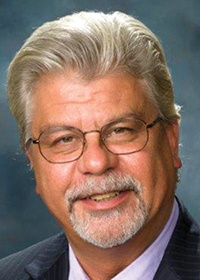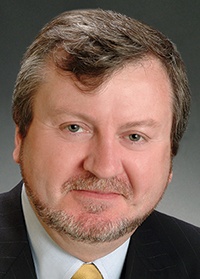Economists describe a ‘resilient’ 2019, with a slowing state economy in 2020
by January 5, 2020 12:01 pm 1,173 views

Mervin Jebaraj, director of the Center for Business & Economic Research in the Sam M. Walton College of Business at the University of Arkansas.
A resilient manufacturing sector and economic “divergence” between Arkansas’ rural and urban areas were realities of the 2019 economy, with growth likely to slow in 2020, according to analysis from three economists. One economist predicts a 2020 state GDP of 1.6%, down from an estimated 1.7% in 2019.
Dr. Michael Pakko, chief economist and state economic forecaster at the University of Arkansas at Little Rock’s Arkansas Economic Development Institute, is surprised Arkansas’ economy in 2019 did not perform better relative to the U.S. economy.
“Overall, we saw the Arkansas economy continue along the growth path that has been in place over the past five years. Income, employment and spending all continued to increase, but at a pace slower than the U.S. economy. My expectations had been for a greater degree of convergence in growth rates, with the Arkansas economy picking up steam,” Pakko told the Northwest Arkansas Business Journal.
MANUFACTURING SURPRISE
Pakko and Mervin Jebaraj, director of the Center for Business and Economic Research at the University of Arkansas’ Sam M. Walton College of Business, were surprised by the strength of Arkansas’ manufacturing sector during 2019.
Manufacturing has been on the upswing, with employment hitting 165,000 in February, the first time sector employment was above that mark since April 2009 when employment was 166,100. October manufacturing employment — the latest data available — was 164,300, up 2.24% from the 160,700 in October 2018. By way of comparison, total employment in Arkansas was up 0.97% in the same 12-month period. However, the sector — once the crown in Arkansas’ economy — remains well below peak employment of 247,600 in February 1995.
“Manufacturing’s resilience in Arkansas was surprising,” Jebaraj said. “Nationally, as a result of the tariffs, the manufacturing sector shed jobs in 2019 and various indices have the sector in a recession, but Arkansas is bucking that trend for now. Nonetheless, I think the manufacturing sector in Arkansas could have been stronger without the tariffs.”
Dr. John Shelnutt, administrator for Economic and Tax Research with the Arkansas Department of Finance and Administration, said the state’s manufacturing sector has benefited from being in more stable categories.
“Our sectors are doing well because they are in less volatile categories such as processed foods or continuously upgraded such as the mini-mill steel corridor,” Shelnutt noted.
ECONOMIC GAP
An economic growth gap between the state’s rural and urban areas was an issue going into 2019. For example, going into 2018, employment data indicated that more than 54% of job growth came from seven of the state’s 75 counties (Benton, Craighead, Faulkner, Pulaski, Saline, Sebastian and Washington). That may ease somewhat but is not likely to reverse trend in 2020. Pakko said a factor in the divide is the “transformation” from a goods-producing economy to more of a service sector economy.

“From the beginning of the decade through 2018, only 33 of the state’s 75 counties experienced positive job growth, and those counties tended to be clustered in and around the state’s metropolitan areas,” Pakko noted. “This trend is closely related to the transformation of employment from goods-producing to service-providing sectors. Service sectors tend to agglomerate nearer to population centers, while manufacturing and other goods-producing activities are more geographically dispersed.”
He believes continued growth in manufacturing and construction sectors could result in a “somewhat more balanced growth pattern” between rural and urban Arkansas. Jebaraj said most of the state’s job creation continues to come from central Arkansas, northeast Arkansas and Northwest Arkansas. In fact, job creation in the three metros makes up for losses in other areas. Between October 2018 and October 2019 job growth in the three metro areas totaled 17,159 (10,984 in Northwest Arkansas; 4,535 in central Arkansas; and 1,640 in the Jonesboro metro,) more than the 12,736 new jobs statewide in the same period.
To remedy the divide, Jebaraj said, Arkansas officials need to “target entrepreneurship resources and business development anchored at higher education institutions in more rural parts of the state.” Shelnutt believes more jobs were available in rural areas in 2019, but suggested better data might help state officials and economists better track work patterns.
“[If] we had better real-time tracking and reporting we would see more workers in Arkansas commuting to jobs with the side benefit of lower gasoline prices than the national average and one of the lowest cost of living averages among the 50 states,” Shelnutt noted.
2020 EXPECTATIONS
The Arkansas economy in 2020 is “likely to slow,” according to Pakko, with manufacturing sector growth to abate somewhat and “steady trend growth in the service sector. He said effects from the 2017 federal tax cuts and uncertainty around global trade will be a headwind in 2020. However, Pakko predicts Arkansas GDP growth for 2019 will be 1.7% for 2019, with a slight slowdown to 1.6% in 2020. He also estimates U.S. GDP growth of 2.3% in 2019 and slowing to 2% in 2020.
“My forecast for 2020 is somewhat optimistic in the sense that I expect the manufacturing sector to continue to expand, albeit at a slightly slower pace than in the past year or so (with employment growth down from nearly 2% in 2019 to less than 1% in 2020). Meanwhile, steady trend growth in service-providing sectors is expected to continue,” Pakko said.

Jebaraj also agreed that the tax cuts, which helped consumer spending, have cycled out. Also, consumers may become more concerned about tariff wars and the global economic slowdown. Jebaraj predicts U.S. GDP in 2020 will be less than 2%. And while Arkansas’ manufacturing sector may continue to improve, it’s no longer enough of the state economy to drive overall growth.
“In Arkansas, the strong employment growth in the second half of 2019 came in the professional and business services sector, so we expect that to continue into 2020. Although manufacturing employment is back to previous levels, manufacturing is still a smaller portion of the Arkansas economy than it used to be and will likely remain that way,” he said.
Shelnutt provided a sector-by-sector look at Arkansas’ economy in 2020:
- The agriculture/farm sector will benefit as value-added farm exports in poultry take advantage of greater market access in China.
- The information sector will stabilize after losses in 2019.
- The retail and restaurant sectors will benefit from stable and growing incomes across a wider segment of the labor force and communities.
- Professional services and finance will continue to do well in growing the economy at state and regional levels.
- The gaming sector is in an expansion phase for now and the next several years.
- Health services has seen a blend of cost cutting and service expansion at regional centers, but the outlook for rural hospitals remains guarded.
- The government sector will remain flat, which places the emphasis on tracking the private sector for gauging the health of the economic expansion.
“As for GDP growth nationally, we see trend growth of about 2% real growth continuing across 2020 and the potential for slight downshift below trend in late 2021 as fiscal stimulus trails off and a slow upturn in Fed interest rates begin,” Shelnutt wrote.
